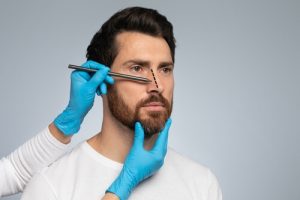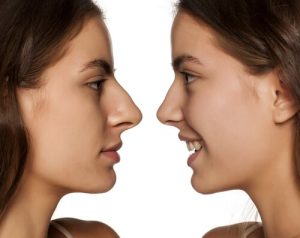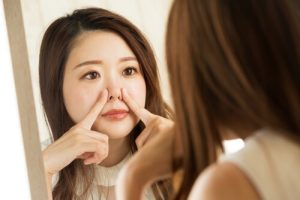In the intricate tapestry of facial aesthetics, a beautiful nose stands as a centerpiece, often capturing the attention and admiration of onlookers. As nuanced as art and as diverse as nature, our understanding of what defines such beauty is a topic of professional inquiry and personal introspection.
As you delve into this article, prepare to embark on a journey that will not just highlight the contours and angles of narrow nostrils that might define this elusive beauty but also challenge realistic expectations and enrich your perceptions. What does it truly mean to possess a beautiful nose shape? The answer might surprise you.
Most Attractive Nose Shape: Which One Is Yours?
Sitting right at the center of our faces, the nose significantly influences our overall look. Across the world, perceptions of beauty vary, but certain nose shapes have historically stood out as particularly attractive. Let’s delve into some of the most talked-about nose shapes and see which ones tend to be more or less prominent in discussions of beauty:
Greek Nose:
- Features: Characterized by its straight bridge and a lack of any pronounced hump.
- Popularity: Often cited as a classic example of beauty, thanks to its refined and symmetrical appearance.
Hawk Nose:
- Features: Notably curved or slightly concave with a more pronounced bridge.
- Popularity is less prominent in traditional beauty standards but has a unique, distinguished look.
Celestial Nose (Also known as a “Button Nose”):
- Features: Small with a slightly upturned tip.
- Popularity: Quite popular, often associated with youthful and cute aesthetics.
Aquiline Nose:
- Features: A slightly curved or convex shape resembling an eagle’s beak.
- Popularity: Seen as regal and noble in some cultures; a middle-ground in terms of prominence.
Hook Nose:
- Features: Similar to the hawk nose but with a more pronounced curve.
- Popularity: Less commonly cited in conventional beauty ideals.
Small Nose:
- Features: Petite in overall size but can vary in shape.
- Popularity: Often considered delicate and attractive, especially in feminine beauty standards.
Roman Nose:
- Features: A pronounced bridge, giving it a strong profile.
- Popularity: Holds a historic charm and is associated with strength and leadership.
Factors that Make an Attractive Nose Shape

In the symphony of facial features, the nose plays a pivotal role, setting the tone for harmony and balance. Yet, what are the elements that truly craft an appealing nasal profile? Let’s dive into the nuances.
Geometry and Proportions:
- The Golden Ratio: Understanding the ideal proportions that resonate with human aesthetics.
- Balance with other facial features: How the nose aligns with the eyes, lips, and chin.
Structural Integrity:
- The Bridge: The significance of its straightness and width.
- Nostrils and Tip: Their role in enhancing or diminishing the nose’s appeal.
Texture and Finish:
- Skin Quality: The impact of smoothness and evenness of tone.
- Scarring and Blemishes: Their subtle influence on overall attractiveness.
Natural Flow:
- The curve and angle: How they contribute to a nose’s overall charm.
- A reflection of heritage: The beauty of noses that echo one’s cultural and genetic tapestry.
As we dissect these intricate details, it becomes evident that attractiveness is not just a matter of size or shape but a confluence of many factors that come together in a delicate dance of nature and nurture.
What is considered the perfect nose shape?

Across the world, a rich tapestry of cultures, landscapes, and histories presents a varied palate of beauty standards. Among these, the topic of the ‘perfect’ nose bent or curved shape often emerges with much intrigue.
Historical Reverence:
- Indigenous roots: How Aboriginal and Torres Strait Islander heritages have traditionally viewed nasal beauty.
- Colonial impressions: The influence of British and European.
Modern Mosaic: Multicultural Influence
- The Asian impact: The growing appreciation for refined, straight profiles given the increasing Asian-Australian population.
- Mediterranean and Middle Eastern nuances: The allure of strong, pronounced nasal structures in our diverse society.
Contemporary Perspectives:
- Media and celebrity influence: Identifying popular figures and their nose shapes that resonate with the public.
- Medical viewpoints: What plastic surgeons observe as the most-requested nose shape features.
Nature and Beyond:
- Natural beauty: Embracing the sun-kissed, relaxed attitude that values genuineness.
- Cosmetic enhancements: The rising trend of rhinoplasty and non-invasive procedures to achieve perceived perfection.
By the end of this exploration, it’s evident that while there may be trends and popular viewpoints, the perfect nose shape is diverse.
Which is better, straight or downturned nose?

The contours of our noses, whether straight or downturned, serve as more than mere physical attributes; they tell tales of our ancestry, personality, and individual uniqueness. Yet, when the question of superiority arises – which is truly better, a straight nose attractive or a downturned nose? – the answer is deeply nuanced.
Aesthetic Appeal:
- Straight Nose: Often viewed as symmetrical and balanced, giving a harmonious alignment with other facial features.
- Downturned Nose: Offers a distinctive and often regal character to the face, reminiscent of classical sculptures and art.
Cultural Insights:
- Straight Nose: Commonly revered in many Western societies, often associated with classical beauty standards.
- Downturned Nose: Celebrated in various cultures for its distinctive look, often linked to wisdom and nobility in folklore.
Functionality and Health:
- Straight Nose: Generally offers an even airflow and can be less prone to certain respiratory issues.
- Downturned Nose: Depending on the degree of downturn, it might sometimes indicate potential breathing challenges, but this is not always true.
Personal Resonance:
- Embracing one’s individuality, regardless of societal preferences.
- The trend towards celebrating natural features and moving away from ‘one-size-fits-all’ beauty standards is increasing.
What are the Various Nose Models in Men and Women?
The nose, a central facial feature, varies vastly among individuals, acting as a telltale sign of our genetic makeup, cultural background, and character. As we delve deeper into understanding the diverse models of noses across genders, some striking distinctions and shared commonalities come to the fore.
Classic Distinctions:
- Men: Often characterized by broader bridges, larger nostrils, and a more pronounced nasal tip.
- Women tend to have softer, more refined structures with narrower bridges and subtler tips.
Prominent Models:
- The Roman Nose: Defined by its strong bridge, which may slightly curve or protrude, commonly found in both genders but more pronounced in men.
- The Snub Nose: With its subtle, upturned tip, it offers a youthful appearance, often associated with women.
- The Aquiline Nose: Curved like an eagle’s beak, it’s seen in both men and women but tends to be more prominent in men.
- The Nubian Nose: Known for its wide base and nostrils, it can be found in individuals of both genders.
Modern Interpretations:
- The influence of cosmetic enhancements: Rhinoplasty trends often seek to achieve specific models.
- The merging of gender norms: A shift from strictly ‘masculine’ or ‘feminine’ nose models favoring individual preferences and natural beauty.
Cultural Nuances:
- How different civilizations and ethnicities have their distinctive nose models.
- The celebration of diversity in nose shapes across the countries reflects our multicultural tapestry.
How do Plastic Surgeons Measure Facial Symmetry?

Facial symmetry is often hailed as a cornerstone of aesthetic beauty, a dance of balance where each feature mirrors its counterpart. But when it comes to achieving this delicate equilibrium, how do plastic surgeons, the architects of the cosmetic world, precisely measure and map it out?
Tools of the Trade:
- Calipers and Rulers: Traditional yet precise, they assist in taking accurate measurements between facial landmarks.
- 3D Imaging Systems: Modern tech that provides a detailed, three-dimensional view of the face, highlighting asymmetries not visible to the naked eye.
Key Landmarks:
- Eyes: Measuring the distance between the inner and outer corners, ensuring both eyes align horizontally.
- Nose: Checking the straightness of the bridge and ensuring the nostrils are even.
- Lips and Mouth: Ensuring the midline of the lips aligns with the nose and chin and that the width of the mouth is proportionate to its height.
The Golden Ratio:
- Application of the famed 1:1.618 ratio is believed to yield the most aesthetically pleasing results. This mathematical principle aids surgeons in achieving the desired proportions between facial features.
Beyond Mere Measurements:
- Recognizing that while symmetry is crucial, individuality and character also play pivotal roles in facial attractiveness.
- Considering the patient’s unique features, preferences, and desired outcomes to tailor interventions.
Is Button Nose The Most Attractive Nose Shape for Females?

The concept of attractiveness is subjective and varies across cultures, time, and individual preferences. Certain trends and preferences emerge based on societal standards, media influence, and cultural factors.
The “button nose,” characterized by its small, round, and slightly more upturned nose in appearance, has often been considered cute or attractive in many Western societies, particularly in popular media. This type of nose is often associated with youthfulness and is frequently seen in animated characters, further emphasizing its connection with endearing qualities.
However, other cultures or regions may deem different nose shapes more desirable. For instance, in some parts of the world, a more prominent nose with a prominent or strong bridge may be considered a sign of nobility or wisdom.
Moreover, beauty standards evolve. What’s deemed attractive in one era might change in the next. Today, with the global mixing of cultures and the rise of social media, beauty ideals are becoming more diverse. This diversity leads to a broader acceptance of various nose shapes, facial features, and body types.
A Mathematically Ideal Nose shape
When discussing the “mathematically ideal” nose shape, researchers often turn to the concept of the Golden Ratio (approximately 1:1.618). This mathematical proportion has balanced proportions and has been associated with beauty and aesthetics since ancient times.
In the context of the nose, the following points are often considered when referring to this “ideal” proportion:
- Length of the Nose: The ideal nose length (when viewed in profile) is approximately equal to the distance from the chin to the base of the nose multiplied by the Golden Ratio.
- Width of the Nostrils: The width of an individual nostril should ideally be about 1:1.618 in proportion to the space between the nostrils.
- Position of the Nose Tip: The distance from the base of the nose to the tip, with the distance from the tip to where the nostrils begin, should also approximate the Golden Ratio.
- Nasal Bridge: A gentle curve or straight bridge is often considered ideal, avoiding pronounced bumps or divots.
- Alignment: The vertical line drawn from the nose’s tip should align with the middle of the chin and the middle of the forehead, indicating the nose’s straightness.
However, it’s important to note that these “mathematical ideals” can come across as overly reductionist. Beauty, especially regarding facial features, is multifaceted and highly subjective. Cultural, historical, and personal preferences play a significant role in determining what one deems beautiful.
What are the Characteristics of a Beautiful Nose?

A nose, often considered the centerpiece of one’s face, holds immense sway in defining one’s overall appearance and aesthetic. But what typically characterizes a beautiful nose? Let’s traverse this intricate landscape:
- Proportion and Balance: Often, a nose deemed beautiful sits harmoniously with other facial features. Its thin nose neither dominates nor recedes, striking a delicate balance that complements the eyes, lips, and overall face shape.
- Symmetry: Like many other features, a symmetrical nose — where the nostrils are even, and the nose bridge itself is a perfectly straight line — is often considered appealing. It offers a sense of balance and alignment.
- Smooth Contour: A gentle, smooth slope, especially when viewed from the side, can be perceived as attractive. This doesn’t necessarily mean a lack of bumps; it’s more about the smooth transition from the bridge to the nose tip to the rounded tip.
- Refinement: A tip that’s not too bulbous or everyone’s nose too pointed often hits the beauty mark. The ideal is somewhere in between, the pointed tip offering a sense of refinement and elegance.
- Natural Appearance: In the era of cosmetic enhancements, a nose that looks and feels natural, even if surgically altered, tends to be more favored. It’s about enhancing, not completely changing.
- Unique Characteristics: Often, it’s the slight quirks — a hint of an upturn, a gentle curve, a barely-there, slight bump — that add character and charm to a crooked nose. These unique traits can transform a nose from ‘beautiful’ to ‘memorably beautiful.’
How to Decide if You Need Nose Surgery Rhinoplasty

The journey to self-enhancement often requires careful introspection and informed decisions, especially when contemplating transformative procedures like rhinoplasty. If you’re mulling over the possibility of nose surgery, here are some pivotal considerations to weigh up:
Understanding Your Motivations:
- Self-Perception: Is this decision rooted in a long-standing desire for change or a fleeting feeling of dissatisfaction?
- External Pressures: Are you considering rhinoplasty for yourself or due to societal or peer pressures?
Health and Well-being:
- Physical Health: Ensure you’re healthy to reduce potential complications and aid recovery.
- Mental Health: It’s essential to approach the decision with a positive and realistic mindset, understanding that while rhinoplasty can enhance facial aesthetics, it might not necessarily change one’s self-esteem or life circumstances.
Research and Consultation:
- Find a Specialist: Seek a reputed plastic surgeon, preferably one specializing in rhinoplasty, for consultation.
- Visualize the Outcome: Modern clinics often employ 3D imaging to provide a sneak peek into potential results.
- Know the Risks: While modern techniques have reduced complications, it’s still crucial to understand potential risks and recovery times.
Financial Considerations:
- Costs: Rhinoplasty can be a significant investment. Ensure you’re financially prepared, considering the procedure and potential post-operative care.
- Insurance and Medicare: Some rhinoplasty procedures may be partially covered, especially those addressing breathing issues. It’s wise to check with your provider.
What Parts of the Nose Can We Change with Rhinoplasty?
The intricate art of rhinoplasty, more casually known as a ‘nose job,’ offers intriguing possibilities. It’s not just about the aesthetic tweak; it’s a procedure of plastic surgery procedures that can reshape, resize, and redefine various elements of the nose. But which parts can truly be transformed? Let’s dive in:
Bridge and Profile:
- Humps and Dips: Surgeons can smooth out a pronounced bridge or fill in minor indentations, giving a sleeker profile.
- Width Adjustments: For those who desire a narrower or broader bridge, surgical adjustments can be made to achieve the desired width.
Tip of the Nose:
- Refinement: A bulbous or overly pronounced tip can be delicately reshaped to provide a subtler, refined look.
- Angle Adjustments: The angle between the upper lip and the nose’s tip can be altered for an upturned or downturned finish, based on preference.
Nostrils:
- Resizing: Whether perceived as too large, too small, or uneven, nostril size and shape can be modified.
- Positioning: The orientation and flare of the nostrils can be adjusted for a more symmetrical appearance.
Internal Structure:
- Breathing Issues: Beyond aesthetics, rhinoplasty can correct structural issues, such as a deviated septum, that may impede breathing.
Conclusion
In the tapestry of facial aesthetics, achieving a beautiful nose shape can be a game-changer. It’s not just about meeting societal ideals but finding a look that resonates with one’s identity. As you navigate the world of cosmetic enhancements, remember that a nose isn’t just a feature—it’s an expression of you.
No doubt, armed with the right knowledge and a sprinkle of self-awareness, crafting that natural, perfect nose silhouette becomes not just a pursuit but a journey to celebrating one’s unique beauty. So, whether it’s through nature’s gift or a more specialist plastic surgeon who’s expertise, let your nose shape be a testament to your individuality.
References
- https://www.hopkinsmedicine.org/health/treatment-tests-and-therapies/nose-reshaping
- https://www.healthline.com/health/exercise-for-nose
- https://www.researchgate.net/figure/Morphological-Classification-of-Human-Nose-based-on-the-Nasal-Index_tbl1_332912694
- https://www.academia.edu/40331290/Nasal_INDEX

